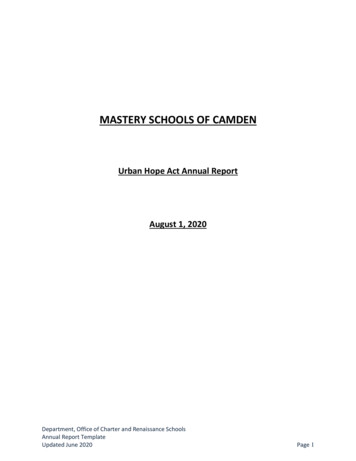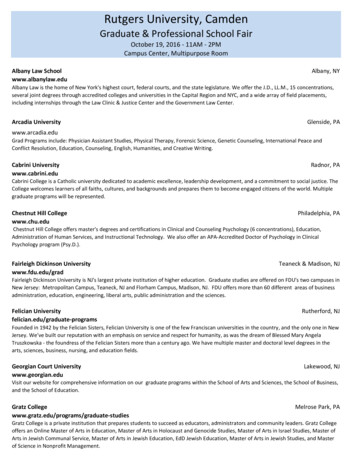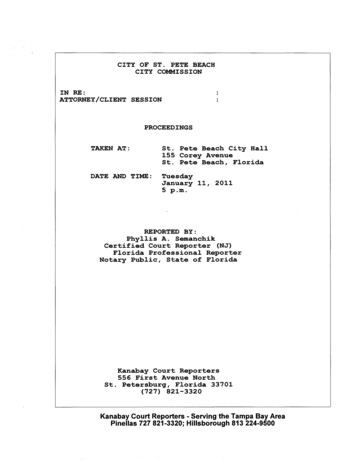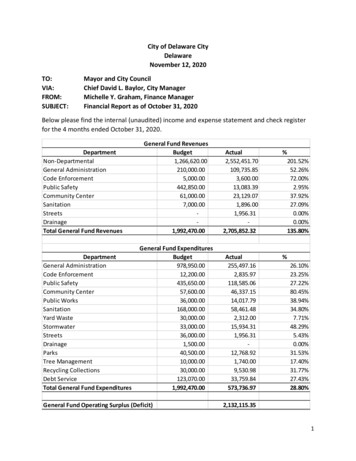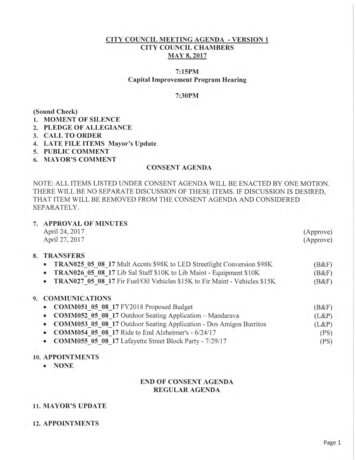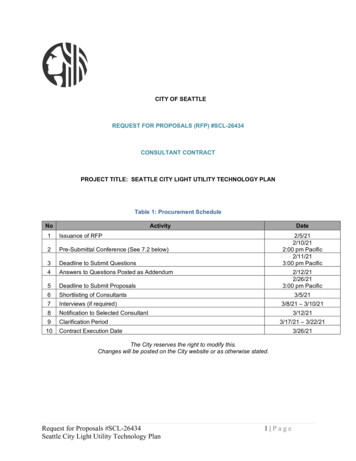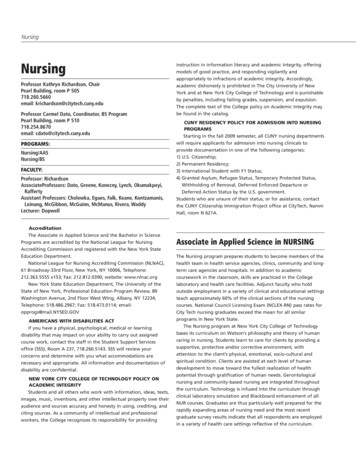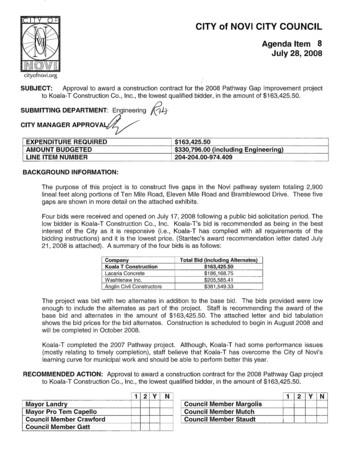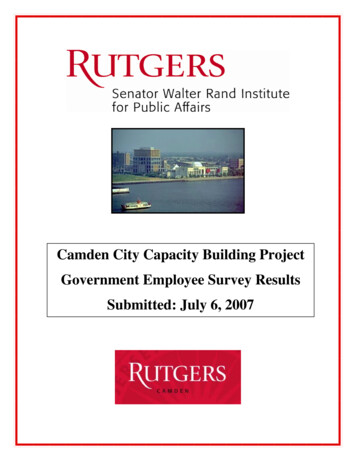
Transcription
Camden City Capacity Building ProjectGovernment Employee Survey ResultsSubmitted: July 6, 2007
Table of Contents1.0Part IExecutive Summary .22.0Description of the Project 32.12.23.0Analysis of the Developmental Skills Survey Results 93.13.23.33.43.53.64.0Background and Introduction .4Methodology and Respondent Profile 6Municipal Operations .9Education Level 10Daily Responsibilities .11Motivation and Incentives .12People Management Skills 13Budgetary Skills 14Analysis of the Technical Skills Survey Results .154.1 Computer Experience 154.2 Basic Computing Skills .164.3 Windows Skills .174.4 Software Applications Skills .174.5 Communications/Internet Skills 185.0Tiers 1 & 2 Training Summary 186.0Appendix A: Developmental Needs Survey Charts and Graphs7.0Appendix B: Technical Skills Survey Charts and Graphs8.0Appendix C: Distributed Survey MaterialsPart II9.0Appendix D: JKA Management Study Reconciliation10.0Appendix E: Camden City Government Capacity Building Retreat11.0Appendix F: Camden Capacity Project Timeline12.0Appendix G: Camden City Council Training1 of 25
1.0 Executive SummaryThe state legislation for the renewal of Camden, the Municipal Recovery and EconomicRevitalization Act, focused attention on the need to rebuild the City’s governmentalcapacity, as well as its physical infrastructure and its economy. An important componentof any serious effort to improve governmental capacity is an assessment of the skills,capabilities and training/development needs of the municipal workforce. While numerousstudies have noted the need for governmental capacity building in Camden, none hadprovided such an assessment. To that end, the Office of the Chief Operating Officer(COO) requested that the Walter Rand Institute (WRI) design a survey of developmentneeds and technical skills of all levels of employees in City Hall.Although funding for this assessment was severely limited, WRI, in close collaborationwith the COO’s Office prepared a two-part survey to provide an initial analysis of themunicipal workforce. For analytic purposes, the workforce was divided into three tiers:Tier 1-department directors (11); Tier 2-supervisory/managerial workers (55); and Tier 3direct service employees (647). Of the 731 non-uniformed employees identified to takethe survey, a total of 439 completed surveys were collected or 61.5% of the city’sworkforce. It is important to highlight, however, that 80% plus of Tiers 1 and 2completed the surveys. Questions probed employees’ understanding of governmentalprocesses and operations, their educational attainment and training, allocation of time tocritical activities, and their responses to motivation and incentive alternatives, as well asinformation technology skills.Major conclusions and recommendations from the surveys are:h Tiers 1 and 2 report a high level of understanding of municipal operations, but arelatively low level of understanding of the role and functions of City Council. Thisfinding aligns with the conclusions of previous studies that there are significantcommunication issues between the governing body and administrative departments;h Tier 3 employees report very low levels of understanding of municipal operations,and this likely reflects lower levels of educational attainment or exposure to training.Additional training and development of staff’s understanding of the CCG’s coremunicipal functions and organization should be sustained at the appropriate level forall tiers.h The level of educational attainment could be significantly improved across alltiers and respondents indicated a desire for greater support of educational and trainingopportunities (less than 50% of Directors have a post-baccalaureate degree and only60% of Supervisors/Managers have a post-secondary degree). The fact that manyacross all tiers have completed some college, but never completed a degree indicatesan opportunity to increase morale and capacity with support.2 of 25
Assisting employees who are driven to further develop their education will increasethe capacity of City Hall’s work force, a process that can be aided through tuitionreimbursement, an advanced degree incentive program, or the establishment offlexible working hours for those employees who are enrolled in classes.h Respondents allocate time appropriate to their level of responsibility, with theexception of Tier 1 respondents who spend relatively little time on communicationsor budgetary and financial matters, concentrating more narrowly on managing peopleand projects.Additional training and professional development is required at all levels of citygovernment to lighten the burden on managing people and projects for upper echelonemployees. As well, with such a large portion of city government resources devotedto daily tasks, more effective time management practices and thus training oneffective time management practices and on how to properly manage a meeting isrecommended.h There are significant opportunities to develop effective systems of non-monetaryreward, especially finding ways to publicly recognize good performance withindepartments, in addition to the employee of the month award.h Among Directors and supervisory personnel there is a self-reported lack ofcomfort with conducting performance appraisals or managing poor performance.Implementation of and training on a more effective system for conductingperformance appraisals and monitoring employees’ routine performance is arecommended necessary first step toward greater efficiency and accountability ofCamden City government.h In Tiers 1 and 2 there is a low level of proficiency reported and a clear desire foradditional training in budget and financial systems.Training in budget development, management and the city’s financial policies andprocedures is recommended for both Tiers 1 and 2.h There is a significant need for increasing IT proficiency across all tiers. In Tier 1,only 55% of respondents identified their computer skills as “intermediate” or“advanced”. In Tier 3, where administrative support staff is well-represented, there isa need for significant training in file management, document sharing, and elementarydatabase management.h The Edmunds financial software is understood by only a very few in City Hall.3 of 25
Increasing familiarity with the existing Edmunds financial system through on-goingtrainings for Directors and those they designate to perform these functions is highlyrecommended.h Significant percentages of employees across all tiers report a need for training insoftware applications ranging from creating basic spreadsheets to employingelementary formulas in spreadsheets to creating charts and graphs;h Significant percentages across all tiers also report the need for training on theInternet and e-mail applications. This training will be especially important if the citymoves to web-based systems for communication, finance, or purchasing. Theefficiencies and effectiveness that e-government systems can deliver are entirelydependent on a critical mass of municipal employees being trained and proficient inInternet and web-based usage.Provide on-going training to City employees using Windows software packages, suchas Word, Excel, and Power Point, as well as training on effectively using e-mail andconducting research on the Internet.2.1 Background and IntroductionThe original Municipal Recovery and Economic Revitalization Act (MRERA) legislationcalled for Rutgers University to provide the Camden City Governing Body (City Council)with three deliverables: an assessment and design of necessary information systems;support in the identification and hiring of two non-partisan professional staff positions;and comprehensive training for members of City Council and non-partisan professionalstaff in order to “better enable them to discharge their representative functions in thepublic interest.”In undertaking these tasks, WRI noted to the COO’s Office that designing an information systemfor City Council in isolation from the rest of City Hall would be unwise for several reasons, butespecially because promoting the timely communication of reliable information between Counciland Administration, as well as among departments, was a critical governance issue; the recurrentproblem of tracking of citizen complaints in particular requires a unified IT approach. In addition,WRI observed that a number of previous studies had identified challenges in governmentcapacity development that focused on the relationship of City Council to the administrativedepartments of city government and the capacity of those departments themselves (Casey, 2001;Garnett, 2000; Harris & Santiago, 2000; Walter Rand Institute, Rutgers University, 2000).Several consistent themes emerged from these studies regarding Camden’s municipalgovernment, including poor communication between Council and administration, City Council’slack of necessary time, expertise, and staff resources to play an effective role in the complexissues that came before its members, low employee skills and training relative to jobrequirements, weak and inconsistent employee accountability systems, inconsistent humanresource management practices across departments, inexperienced/poorly matched managers andinformation technology staff.4 of 25
The Walter Rand Institute, in conjunction with the COO’s Office, developed a morecomprehensive capacity-building proposal that would incorporate both the legislative andexecutive branches of government and would use the redesign of the City’s IT system as a driverfor changing the organizational culture of City Hall and improving governing capacity. TheCamden Capacity Building Project (CamCap) was formulated to proceed in two phases: the firstentailing a situational analysis, setting an agenda for capacity building, and development of an ITdesign that would support capacity-building goals and the second phase was intended toimplement the agenda, the IT plan, and the training programs necessary to sustain capacitybuilding changes.In Phase I, WRI facilitated two leadership development and training retreats attended by theCOO, the Mayor, department directors and City Council members. Participants in the first retreat,held at the Forrestal Center in Princeton, drafted vision and mission statements for the City:Vision: To transform Camden into a City that is linked to its people byresponsible service systems, state of the art technology and accountable decisionmaking processes.Mission: To serve and build Camden’s diverse community by effectively,efficiently and equitably enhancing residents quality of life; attracting privateinvestment, stimulating growth city wide and delivering services with acommitment to excellence.The City Council adopted the mission and vision by resolution following the first retreat.At the first retreat, participants also identified six key areas for improvement in governmentalcapacity:1. Communication (external as well as internal);2. Government processes;3. Technology;4. Accountability;5. Training;6. Resources.Retreat participants organized internal working groups comprised of Directors and/or CouncilMembers and facilitated by WRI to address each area. Each working group was responsible fordeveloping a capacity building agenda in their particular area and reporting back to the COO andthe Mayor at a second retreat.The second retreat reviewed the analyses and recommendations of the six working groups andagreed on action plans to achieve their goals and objectives. (See attached PowerPoint inAppendix E) The key to driving organizational change in City Hall was to be the 1.4 million forIT implementation, but financial constraints at the state level resulted in this never being fundedand in significant delays in funding for the other implementation and training components (Asummary of all service and deliverables provided for Phases I and II of CamCap are provided inAppendix F). As state funding for the project (as well as other initiatives in Camden) generallybecame more uncertain and Ms. Manzano-Diaz was hired to drive the government capacity5 of 25
building efforts from the COO’s Office, she was forced to focus on less ambitious changes thanoriginally anticipated under CamCap.In particular, the IT-driven change strategy involving the six working groups had to be shelved infavor of a radically scaled-back program of IT upgrades and an employee survey to determinetraining needs followed by a series of training modules for directors, middle managers and linestaff (designated as Tiers 1, 2 and 3 respectively). The COO’s Office also arranged for Microsoftto offer some basic training in elementary computer skills. Pursuant to the original language inMRERA, separate training sessions for City Council and its staff were developed by WRI andthe COO’s Office in consultation with City Council (See Appendix G for related materials). WRIworked closely with Ms. Manzano-Diaz and the COO’s Office to design and administer theemployee survey and to provide training to upper and mid-level management, Tiers 1 and 2. 1What follows is a report on the results of the employee survey and subsequent training sessionsthat WRI executed under the scaled-back program of government capacity building for the Cityof Camden.2.2Survey Methodology and Respondent ProfileDuring the summer of 2004, WRI was asked by the Office of the Chief Operating Officerfor the City of Camden to design, implement and analyze a system-wide survey thatwould provide information about Camden City government employees’ professionalperformance and technical skills. Part of the scaled-back effort outlined in the MRERAlegislation to build governmental capacity, this survey was intended to augmentinformation developed in WRI’s initial needs assessment and the Management Studyperformed by Joshua Kim Associates (JKA). In conjunction with these and otherpreviously collected data, the survey findings were intended to drive future Camden Citygovernment professional development and training.Two separate surveys were designed in order to capture self assessments of the CamdenCity municipal employees, in the areas of both professional development and technicalskills. WRI designed the professional development survey and sub-contracted with VirtusPartners to design the technical skills survey.Potential respondents to the employee survey were identified from the 2004 Camden Citygovernment (CCG) list of civilian employees, prepared by the then Human ResourcesManager. This list did not include direct service uniform employees (i.e. thoseindividuals assigned to the Police and Fire Departments) 2 . WRI team members later1The New Jersey Department of Personnel (NJDOP) conducted training to improve employee accountability andcustomer service for Tier Three. The COO’s Office also worked with Rutgers and NJDOP to further increasecapacity.2During the survey collection period, the Police Department was going through a system-widereorganization prompted by the report of the NJ Attorney General’s Blue Ribbon Commission and6 of 25
identified and incorporated uniformed direct service Fire personnel as additional surveyrespondents, thereby adding uniformed personnel from this department to the original2004 civilian list. In addition, eight upper- and mid-level managers (Tier 1 and Tier 2)from the Camden City Police Department participated in the survey.Participating employees represented all nine CCG departments, as well as the MunicipalClerk, City Council, Mayor and Municipal Court units. Please refer to Table 1 below fora full list of participating CCG units. As Table 1 indicates, 61%, or 439 employees, ofthe total available employees participated in the survey from March 2005 throughDecember 2005. Several CCG employees chose not to participate in the survey, citingconfidentiality concerns. 3 Further, the work schedule of City Hall employees, as well astime and resource constraints, further diminished the ability of WRI to approach a 100%survey yield of city employees.Table 1 – Aggregated Participating Camden City Government Employees x Unitand Percentage (Source – 2004 CCG Civilian Employee List)Camden City Government UnitPersonnel Completed Unit %ListedSurveysCompletedAdministrationCity AttorneyCity ClerkCity CouncilCode EnforcementDevelopment & PlanningFinanceFireHealth & Human ServicesMayorsMunicipal CourtPolicePublic WorksSubtotalAvailable %5%79%51%61%supersession role of the Prosecutor’s Office. As such, it was determined that surveying the full PoliceDepartment would not be prudent; only the senior and middle Police levels of the Department participatedin the data collection and subsequent leadership training.3The office of the COO originally intended for individual survey results to be incorporated into theenhancement of the individual development planning process. Under this plan, survey responses were to beshared with the respondent’s direct supervisor. As witnessed in survey distribution sessions, this approachwas viewed as compromising survey confidentiality.7 of 25
total of 148(or 94.87%)of thealistedPolicewereexcludedfrom the dataOver *aAperiodof eightmonths,seriesof personnelmeetingswerescheduledwithcollectionWRI teamprocess; due to the department reorganization there were an additional number of direct service stgroupconsistedofthe Directorpolice personnel unavailable for this survey.level of the organization (referred to as Tier 1); the survey was distributed as part of theirregularly occurring bi-weekly Directors’ meeting. The second cohort, Managers (or Tier2) consisted of Supervisors up to and including Assistant Directors. Tier 2 was providedwith three scheduled days of data collection in which they were assigned to time slots(the number of participants surveyed per time slot was approximately 15 CCGemployees). The third and final cohort, direct service CCG personnel (Tier 3), wereprovided with 10 scheduled days for data collection, either in a large central location (i.e.,Camden City Council Chambers) or on-site (i.e., Fire Department and Department ofPublic Works). See Table 2 below for distribution of survey respondents by tier.Table 2 – CCG Tier Survey DistributionCCG TiersPersonnelListedCompletedSurveysUnit %CompletedTier 1 – Director Level11981.8%Tier 2 – Manager Level554480.0%647*38659.771343961.5%Tier 3 – Direct Service LevelTotal*The number of Tier 3 personnel does not include Uniformed Police Officers. This exclusion affects thepercentages associated with this Tier 3 figure as well as the total.Participating CCG employees were provided with a paper survey instrument consisting ofthe ‘Developmental Needs’ survey, the ‘Technical Skills’ survey, and an envelope as asingle survey package. At the start of each data collection period, WRI staff orallypresented an introduction, instructions, purpose, and confidentiality statement related tothe survey (please see Appendix C for a complete survey package). Each completedsurvey was sealed in the envelope to ensure respondent confidentiality. The completedsurveys were taken off-site by WRI staff for entry and analysis. The data was enteredand analyzed using Survey Pro 3.0, Microsoft Excel 2003, and Statistical Program forSocial Sciences (SPSS) 14.0.The survey analysis is presented below at two levels of the organization: an aggregate ofthe total number of participants and by tier. The data is also provided by department inthe appendices of this report, though robustness of the analysis by department is limitedbased on the variable and i
h The Edmunds financial software is understood by only a very few in City Hall. 3 of 25 . Increasing familiarity with the existing Edmunds financial system through

